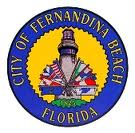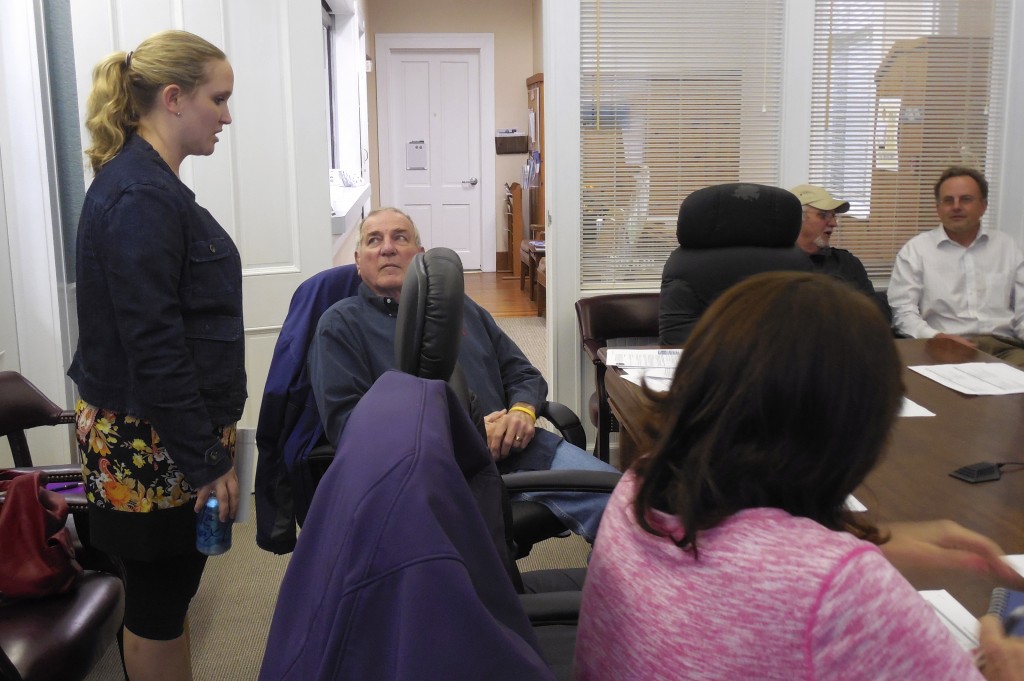Submitted by Suanne Z. Thamm
Reporter – News Analyst
 At a special meeting on February 26, 2014 in the Fernandina Beach City Hall Conference Room, members of the CRA Advisory Board (CRAAB) engaged in robust discussion among themselves and with half a dozen members of the public over the relative merits of two plans for a waterfront park on the Amelia River at the foot of Centre Street. After close to two hours of discussion, the CRAAB voted unanimously to send the following recommendation to the Fernandina Beach City Commission (FBCC): substitute the plan submitted by Partnership for the Amelia Riverfront Park (PARP) for the Parking Lots A and B sections of the approved Waterfront Advisory Group (WAG) plan, require PARP by July 4, 2015 to develop a fundraising plan, a marketing strategy, and a risk analysis demonstrating the effect of the substitution on the remaining parts of the WAG plan for future expansion. Along with this recommendation, the CRAAB will also forward a list of pros and cons of each plan for FBCC consideration. CRAAB Chair Mike Zaffaroni expressed a sense of frustration at having to decide between the competing plans, when he would have preferred that the authors of the plans come together to present one plan to reflect interests of all parties. CRAAB member Lou Goldman said, “That will never happen. Pride of authorship is at stake, as well as the issue of private funding.”
At a special meeting on February 26, 2014 in the Fernandina Beach City Hall Conference Room, members of the CRA Advisory Board (CRAAB) engaged in robust discussion among themselves and with half a dozen members of the public over the relative merits of two plans for a waterfront park on the Amelia River at the foot of Centre Street. After close to two hours of discussion, the CRAAB voted unanimously to send the following recommendation to the Fernandina Beach City Commission (FBCC): substitute the plan submitted by Partnership for the Amelia Riverfront Park (PARP) for the Parking Lots A and B sections of the approved Waterfront Advisory Group (WAG) plan, require PARP by July 4, 2015 to develop a fundraising plan, a marketing strategy, and a risk analysis demonstrating the effect of the substitution on the remaining parts of the WAG plan for future expansion. Along with this recommendation, the CRAAB will also forward a list of pros and cons of each plan for FBCC consideration. CRAAB Chair Mike Zaffaroni expressed a sense of frustration at having to decide between the competing plans, when he would have preferred that the authors of the plans come together to present one plan to reflect interests of all parties. CRAAB member Lou Goldman said, “That will never happen. Pride of authorship is at stake, as well as the issue of private funding.”
At its joint meeting with CRAAB on February 12, 2014 (see earlier FO article), the FBCC decided that it would listen to formal proposals from both PARP and WAG at a special meeting before making a decision to proceed with either plan. The FBCC asked the CRAAB to provide input regarding the pros and cons of each plan. CRAAB has consistently supported building a waterfront park as a spur to economic development in the CRA, or community redevelopment area, along the waterfront. The FBCC Special meeting has not yet been scheduled.

Senior Planner Kelly Gibson clarified for CRAAB members and the public the genesis of the WAG plan. She said that park planning began in earnest in 2006 with the Waterfronts Partnership Committee. The following year the Parks and Recreation Advisory Committee also surfaced a plan. Both plans were melded into a joint plan that stretched from southern limit of city waterfront property to the northern limit. This plan was approved by the FBCC in 2009. But because that plan eliminated the boat ramp, it needed to be revised when the city decided to keep the boat ramp in its current location. A subset of the original joint committee, called the Waterfront Advisory Group, came together to revise that plan which the FBCC adopted in 2012. Although the city had commissioned and paid for about 90% of the engineering and permitting needed for the park, when the FBCC voted to return money borrowed to begin the project, all work on the park stopped.
In deliberating their charge CRAAB members narrowed their focus to the comparable areas of each plan: areas today known as Parking Lots A and B located at the foot of Centre Street and an area bounded roughly by the Marine Welcome Center on the south and the boundary of city marina property on the north. They avoided weighing the merits of specific design elements. At several points during the discussion members stressed that they were not abandoning the WAG plan, but only considering one portion of it, anticipating that the other areas of the WAG plan would remain part of the long range waterfront park plan.

The discussion and final recommendation appeared to stem from what CRAAB members saw as an opportunity to attract private investment with the PARP plan that would result in a more attractive waterfront in a smaller, more concentrated area at the foot of Centre Street, where more pedestrian traffic would likely visit. CRAAB member Debra Stephenson stressed that she saw more functionality in a smaller area in the PARP plan that would bring park elements to where the people shop and naturally congregate. She felt that the WAG plan included too many functions, too spread out.
All members agreed that building either plan would help the CRA attract developers. However, CRAAB member Lou Goldman said that getting something built today was a critical factor. He suggested that the smaller PARP plan might be the only plan that the city would be able to implement within a 20-year period. Goldman also pointed out that the only real differences between the portions of the two plans under consideration involved what is today Parking Lot B. The PARP plan included elements that would be suitable for private fundraising.

Randy Rice, the local architect behind the PARP plan, and Eric Bartelt, a member of the WAG, politely sparred over some plan differences. They agreed that their respective treatments of Parking Lot A were virtually the same, but Bartelt believed that the cost of the WAG plan for Parking Lot B was less than the PARP plan. Rice said that costs were not germane because the PARP plan provided for private funding. Both men talked about the possibility of Florida Inland Navigation Department (FIND) matching grants to assist in funding. But although Rice and Bartelt, along with CRAAB members, had discussed the possibility of such grants with the local FIND representative, they had not all received the same assurances.

Rice, in response to a question, said that under the PARP plan, the park would belong to the city and that the city would run the improvement project. Construction would need to meet all city requirements, and that the city would have input on the design elements. He said that the PARP fundraising would parallel that of the Friends of the Library, who worked with the city and the county on the library expansion/renovation plan. Just as the library project involved private contributions to assist in improving a public building, PARP would raise money for the city to improve a public park.
Chair Zaffaroni said that in his mind, the WAG plan died when the city returned the money borrowed to begin work on it under Forward Fernandina Strategic Plan. He asked rhetorically, “Is it the Rice Plan [PARP] or nothing?” He also acknowledged under discussion of pros and cons that the WAG plan had been developed with significant public input while the PARP plan was developed by a small group.

Lowell Hall, an involved local citizen who has championed public access to local beaches and shores over many years, said that his main concern remains public access to the Amelia River. He said, “I see [the PARP plan] as the WAG plan with a few modifications to Parking Lot B.” Goldman suggested postponing work on Parking Lot A because of the loss of parking spaces. He said that at some time the city will need to build a parking garage and claimed that he had identified three potential locations.

Bartelt presented what he called “WAG-2,” a redesign of the WAG plan for Parking Lots A and B, which added more parking along the west side of the railroad tracks. He said that the WAG had not reviewed or approved this redesign. Because of sunshine law requirements, he was not able to consult with other WAG members. He added that only the city could convene a meeting of the group. CRAAB member Andy Curtin said that the plan should be called “Bartelt-1,” since it had no official standing. CRAAB members decided that they could not consider that plan as part of their current charge. Curtin said that the Bartelt plan would need to come to CRAAB from WAG to be considered. At that point, Randy Rice asked that the discussion just deal with what is officially before the board now.
Debra Stephenson said, “We need to get people engaged and energized.” To that end, she moved and Curtin seconded the recommendation to the FBCC to substitute the plan submitted by PARP for the Parking Lots A and B sections of the approved WAG plan, require PARP by July 4, 2015 to develop a fundraising plan, a marketing strategy, and a risk analysis demonstrating the effect of the substitution on the remaining parts of the WAG plan for future expansion. The motion was approved unanimously. A previous similar motion made by Goldman failed on a 3-1 vote, with Zaffaroni opposing due to the exclusion of Parking Lot A. [Note that because the CRAAB currently has two vacancies on its 7-member board, a measure needs 4 votes and to pass. Only 4 of the 5 current members attended the February 26 meeting, meaning that all 4 needed to be in agreement to pass a motion.]

Chair Zaffaroni expressed his concern that there is no driving force behind funding the WAG plan. He said he maintains his interest in completing the entire plan and asked Rice to ensure that elements of the PARP plan dovetail with the other elements of the WAG plan, which were not put together “in a whimsical fashion.” Rice said that his plans call for using leftover funds from the PARP plan to be placed in a trust fund to be used for completion of the WAG plan. CRAAB members also expressed optimism that development that would be spurred on by the completion of the PARP plan would also generate funds for that purpose.
City Commissioner Pat Gass, the FBCC commissioner-liaison to the CRAAB, did not attend the meeting.
Both plans may be viewed on the city website www.fbfl.us.
 Editor’s Note: Suanne Z. Thamm is a native of Chautauqua County, NY, who moved to Fernandina Beach from Alexandria,VA, in 1994. As a long time city resident and city watcher, she provides interesting insight into the many issues that impact our city. We are grateful for Suanne’s many contributions to the Fernandina Observer.
Editor’s Note: Suanne Z. Thamm is a native of Chautauqua County, NY, who moved to Fernandina Beach from Alexandria,VA, in 1994. As a long time city resident and city watcher, she provides interesting insight into the many issues that impact our city. We are grateful for Suanne’s many contributions to the Fernandina Observer.
February 27, 2014 11:05 a.m.
